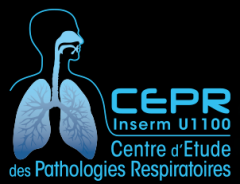Development of an ex vivo preclinical respiratory model of idiopathic pulmonary fibrosis for aerosol regional studies
Résumé
Idiopathic pulmonary fibrosis is a progressive disease with unsatisfactory systemic treatments. Aerosol drug delivery to the lungs is expected to be an interesting route of administration. However, due to the alterations of lung compliance caused by fibrosis, local delivery remains challenging. This work aimed to develop a practical, relevant and ethically less restricted ex vivo respiratory model of fibrotic lung for regional aerosol deposition studies. This model is composed of an Ear-Nose-Throat replica connected to a sealed enclosure containing an ex vivo porcine respiratory tract, which was modified to mimic the mechanical properties of fibrotic lung parenchyma-i.e. reduced compliance. Passive respiratory mechanics were measured. 81m Kr scintigraphies were used to assess the homogeneity of gas-ventilation, while regional aerosol deposition was assessed with 99m Tc-DTPA scintigraphies. We validated the procedure to induce modifications of lung parenchyma to obtain aimed variation of compliance. Compared to the healthy model, lung respiratory mechanics were modified to the same extent as IPF-suffering patients. 81m Kr gas-ventilation and 99m tc-DtpA regional aerosol deposition showed results comparable to clinical studies, qualitatively. This ex vivo respiratory model could simulate lung fibrosis for aerosol regional deposition studies giving an interesting alternative to animal experiments, accelerating and facilitating preclinical studies before clinical trials. Idiopathic pulmonary fibrosis (IPF), a progressive fibrotic disease of the lungs without identified etiology, is the most common form of idiopathic interstitial pneumonia 1,2. Estimated incidence is around 2.8/100000 in North America and Europe, while lower incidences are observed in Asia and South America 3. The spontaneous 3-5 years survival is around 50% 4-6. IPF is characterized by progressive fibrotic lesions extending into the lungs from subpleural regions with a heterogeneous distribution throughout the lung. This leads to impairments of lung mechanics with a prominent reduction of lung compliance 7-12-i.e decreased ability of the lung to stretch and expand during the breathing cycle. IPF symptoms include cough, exertional dyspnea 1,7,13-18 , alterations in pulmonary gas exchange 8,17 , physiology of airways 19 and pulmonary hemodynamics 14-16,20,21. Currently, IPF is treated with systemic antifibrotic drugs, such as pirfenidone and nintedatinib, which have been shown to delay the progressive decrease of lung function and to reduce mortality 3,22-24. However, neither pirfenidone nor nintedatinib stops disease progression, while lung transplantation is associated with significant morbidity and mortality 25-28. Thus, new treatments for IPF are strongly needed. Pulmonary delivery of drugs is expected to be an interesting route of administration as an alternative to systemic therapies in IPF. Indeed, work is ongoing to develop inhaled IPF therapies using either repurposed drugs such as interferon gamma 29 or new chemical entities, such as the α v β 6 integrin inhibitor GSK3008348 30. Nevertheless, optimization of nebulization technologies appears necessary to reach this aim. Indeed, due to the alterations of lung compliance in IPF, aerosolized delivery of treatments remains challenging. Heterogeneous reduction of lung compliance is associated with impaired deposition of aerosol in affected pulmonary regions 31 .
